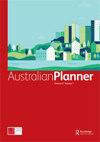Against the grain: public interests, the parklet, and the university
IF 1.5
Q2 Social Sciences
引用次数: 2
Abstract
ABSTRACT Temporary/tactical or T/T urbanism is a global movement in urban design and planning encompassing small experimental interventions typically involving diverse actors in the conversion of under-utilised city spaces. Its outcomes include enhancing innovation, urban intensification, community engagement, place identity, and resilience. Yet questions remain about the extent to which large organisations engaging in T/T urbanism may be part of an increasingly legitimised, even sanitised approach to what has been a disruptive element of urban design and planning. In Tasmania, studies of T/T urbanism are limited. The qualitative research reported here addresses that gap and analyses street interviews and participants’ opinions about a temporary parklet proposed by the University of Tasmania in the Hobart central business district. Analysed thematically, those views and additional insights from the literature suggest it is possible for a large organisation to engage local communities and serve public interests using T/T urbanism initiatives but that the outcomes are not guaranteed.违背常理的是:公共利益、公园和大学
临时/战术或T/T城市主义是一种全球性的城市设计和规划运动,包括小型实验性干预,通常涉及不同参与者在未充分利用的城市空间的转换。其成果包括加强创新、城市集约化、社区参与、地方认同和复原力。然而,对于从事T/T城市主义的大型组织,在多大程度上可能是一种日益合法化,甚至是净化的方法的一部分,这种方法一直是城市设计和规划的破坏性因素,问题仍然存在。在塔斯马尼亚,对T/T城市化的研究是有限的。这里报告的定性研究解决了这一差距,并分析了街头访谈和参与者对塔斯马尼亚大学在霍巴特中央商务区提出的临时公园的意见。从主题上分析,这些观点和来自文献的其他见解表明,大型组织有可能利用T/T城市主义倡议参与当地社区并服务于公共利益,但结果并不能得到保证。
本文章由计算机程序翻译,如有差异,请以英文原文为准。
求助全文
约1分钟内获得全文
求助全文

 求助内容:
求助内容: 应助结果提醒方式:
应助结果提醒方式:


